We began the day at Panera: I indulged in the bear claw while Gary had 2 bagels. Now, that’s usually not a problem but, as the day wore on, it began to look as if it were a big mistake.
Big Adventure today. Usually, we adventure when we travel but sometimes we realize that there is lots to see here in Des Moines and today we’re on our way to the . . .
TA DA!!!
Metro Waste Authority’s Landfill. Well now, you say, who ever wants to go to a landfill? But Gary, I and the other 25 or so on our tour, all thought that the landfill would be a great trip. Unfortunately, the kids on the trip who wanted to see the ‘TRUCKS’ were destined to be disappointed. We didn’t see many trucks and those we did see were about a mile away.
We all gathered at a Junior High parking lot, checked in with the tour guide and waited - and waited - and waited for the bus to come. Hmm. Seems there must have been a problem with the schedule but finally a bus rolled into view and the tour was on.
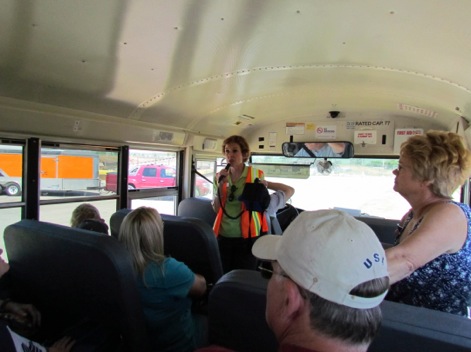
We headed further out of town to a beautiful rolling hill section east of Des Moines where we turned off the road to the Metro Waste Authority.
The facility covers 1800 acres of land with about 500 being used for landfill space. To this one facility is brought 18% of the states waste. Remember how we used to take stuff to the city dump? I remember trips to the dump in Hampstead, NH where we lived in the late 1980’s. We’d take larger things there and toss them into the pile of trash there. We could see bulldozers there flattening it all and pushing it in to the large pit. Yecch.
Well, we’re all much smarter now and have a much greater awareness of what all that trash does to our environment, to our groundwater and to our air. Dumps have been replaced by landfills. Did you know that garbage in a landfill does not decompose? Firstly, much of it is stuff that doesn’t really decompose easily - like metal, glass and plastic. Secondly, in a landfill It just gets compacted and covered. In Des Moines, they dig a pit about 110’ deep, smooth it over even taking out larger rocks by hand so the bottom is completely smooth and won’t break the liner. They used to line the pit with 2’ of very compacted clay but now they line it with - get this - a liner, a thin layer of a very hard stiff plastic. Our tour guide passed around a piece of this for us to examine.
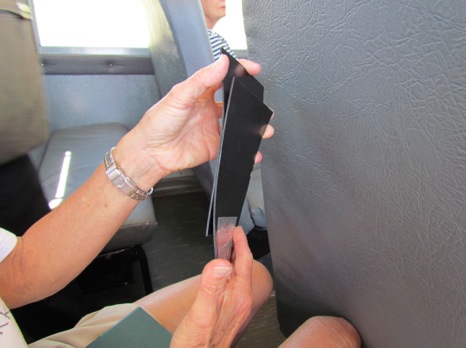
Interestingly enough, my niece, April worked for a company based in Minneapolis that actually planned landfills. She planned and oversaw one in Carroll and one in South Dakota that I remember. I wish I had visited her when she was working in Carroll and had seen what she did with all her explanation.
In the observation area is a diagram of how a landfill is filled, with the liner on the bottom, the smooshed trash and the liner on the top. The long tube going through it is for the methane which is monitored and collected.
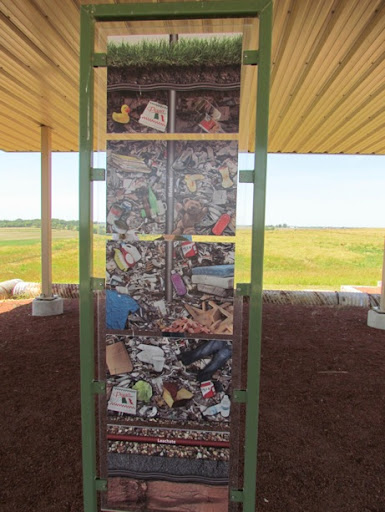
The Metro Waste Authority here in Des Moines serves 16 communities by taking in 2000 tons or garbage per day at their landfill which is about 20 miles outside of town. All those trucks which roll through our neighborhoods early in the morning take the garbage to a transfer center and unload it into a larger semi which can take the garbage from 3 trucks. Then the trucks rumble through some more neighborhoods while the semi takes the garbage to the landfill. Saves time, gas and the roads. And this little minuet is repeated time and time again.
The bottom of the semis is a rolling floor, like the grocery counter where you put your groceries. That way the garbage just rolls out into the pits. Is this more than you wanted to know about garbage? After the garbage is dumped, the bulldozers roll over and over it, smashing it as flat as they can get it. At the end of the day, it is all covered with dirt, all ready for the next days layer. When the pit is filled, another liner is placed on top to cover the pit. And dirt on top of that so that now, it looks like some beautiful rolling hills, covered with grasses.
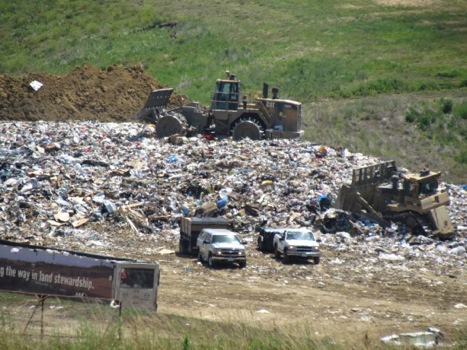
There we were, all of us in the tour, standing on top of a gently rolling hill that looked just like any rolling hill in Iowa but it was Pit #1 which had been filled and covered. And, get this, it is the highest spot in Polk County.
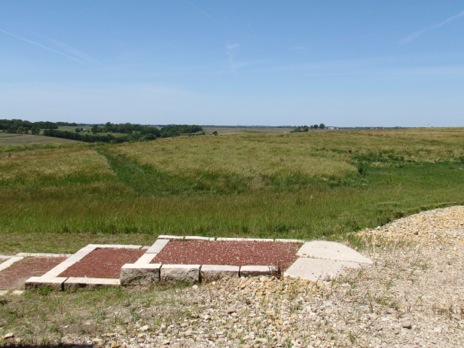
There’s lots more to the story but I’m thinking that you’ve heard all you really want to hear about garbage and landfills. It was a neat tour and I’m glad we went to see how all this is handled in Des Moines.
Now, while I’m on landfills, here’s a neat poster we saw in a museum in San Diego. It describes the harm coming from all those plastic bottles that everyone carries. Gary and I try not to use plastic bottles. We actually have our own water bottles which we wash and fill from tap water and our backpacks have bladders in them to carry water.
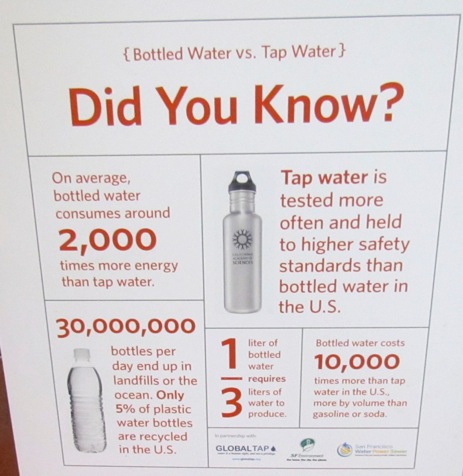
We arrived back at the school about noon and, since we were so close we decided to visit the Neal Smith National Wildlife Refuge and Tallgrass Prairie. Since it is a national site, we had picked up our Senior National Park pass several years ago but just breezed in and out. Today, we decided to give the park its due and spend some time.
The Visitor Center had lots of good exhibits on native prairies which used to cover the whole of Iowa and vast parts of 13 other states in the Midwest. Prairie grasses have exceptionally deep roots (as you can see in the picture below) and because the grasses above ground burned every now and then, the soil became incredibly rich, some of the richest in the world. Thus, it was exceptionally desirable for the farmers as they moved west to settle. And, there went the prairies, about 99% succumbed to the plow. They are now working to restore over 8000 acres of Iowa’s native tallgrass prairie and oak savannah.
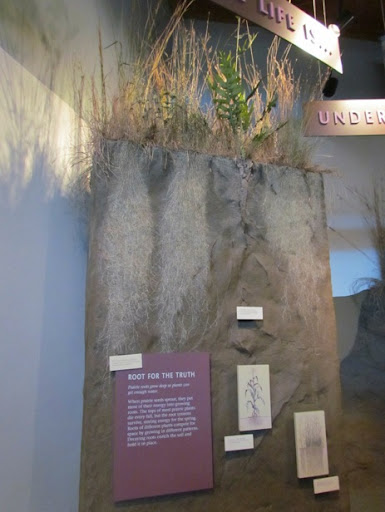
Try to imagine being a farmer in Iowa trying to uproot the prairie grasses with their extensive root system so that you can plant your corn. That would be some task.
There was a lot about how the native bison on the prairie and how they are working to restore a herd. The bison were integral to the growth of native grasses in the prairie. Their hide carried seeds to many areas, when they wallowed in the mud, the seeds came off in the dirt there and when they ate they often got grass seeds in their mouths which eventually were deposited on to the prairie with a bit of fertilizer. I always enjoy hearing how all parts of nature work together to form a whole.
There were extensive exhibits showing native flora and fauna also. However, the best way to see many examples of this is to walk the trails in the park. That’s right down our alley. On our walk we saw the buffalo herd that lives here, native birds and many prairie grasses and flowers. It was a beautiful stroll on a beautiful day.
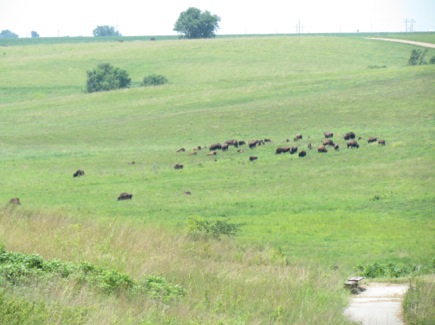

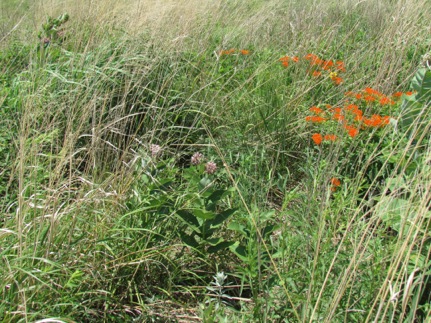
It was an interesting day from the landfill to prairie restoration.
We had not planned to be gone so long today. Our goal was the landfill tour and then home for the afternoon. Thus, I had not taken any extra food, no protein bars, no fruit, no sandwiches, nada, zilch, nil. And, hey, remember that BIG NUTRITIOUS breakfast? Well, then the inevitable adventure creep and were we ever hungry along about 1:00, at 2:00 I could feel the hunger pangs, and at 3:00 I could hear the grumbles. Finally, at 3:30 when we left Neal Smith, we made a beeline for the nearest fast food stop to quiet the growling in our tummies. Now, fast food is not our favorite thing but Burger King has a good salad for $1.59. It’s larger than you might think, has 2, count them 2, grape tomatoes, croutons and variety of greens. Imagine that. And I thought all they sold were burgers, fries and chicken tenders.
Now it’s time to get home for dinner.

No comments:
Post a Comment